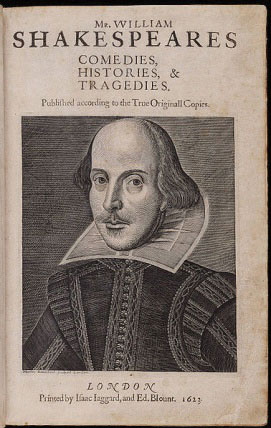This is “William Shakespeare (1564–1616)—The Plays”, section 3.7 from the book British Literature Through History (v. 0.1). For details on it (including licensing), click here.
For more information on the source of this book, or why it is available for free, please see the project's home page. You can browse or download additional books there. To download a .zip file containing this book to use offline, simply click here.
3.7 William Shakespeare (1564–1616)—The Plays
PLEASE NOTE: This book is currently in draft form; material is not final.
Learning Objectives
- Comprehend the significance of Renaissance drama in the history of the theater.
- Understand Elizabethan era printing.
Just as the Elizabethan period is called a Golden Age in British history, the time period in which Shakespeare wrote, acted, and produced plays is a Golden Age of British, and even world, drama. Ironically, hard on the heels of this flowering of Elizabethan drama, the Puritans shut down the theatres in England during the English Civil War. Thus, a dearth of drama quickly followed the wealth of Shakespeare’s time period.
None of Shakespeare’s plays exists in manuscript format. Instead, Shakespeare’s plays have come to us through early published copies, some of which were inaccurately recorded by actors or others who thought to profit by publishing their own copies of the popular plays. During the 16th century, copyrights as we know them didn’t exist. The Stationers’ Company, a city guild for printers and book sellers, controlled what was printed, thus providing a means of government censorship. The Folger Shakespeare Library provides a video explaining Renaissance printing techniques.
Many of the early publications were in quartoa sheet of paper folded into quarters, creating 4 leaves (8 pages), a sheet of paper folded into quarters, creating 4 leaves (8 pages). The British Library and The Shakespeare Quartos Archive provide digital images of all the plays published in quarto.
A folioa sheet of paper folded in half, forming a larger sized book was the same piece of paper folded in half, forming a larger sized book. In 1623, the First Foliothe first complete collection of Shakespeare’s plays, the first complete collection of Shakespeare’s plays, was compiled and published by John Hemminge and Henry Condell, two of Shakespeare’s fellow actors. Digital images of Shakespeare’s First Folio are available from the Folger Shakespeare Library, the Perseus Digital Library, and from the Schoenberg Center for Electronic Text and Image, Furness Collection.

Shakespeare’s plays are generally divided into three categories: tragedies, comedies, and history plays, a division first seen in the First Folio. George Mason University’s Open Source Shakespeare lists the plays by genre.
Text
- The Complete Works of Shakespeare. Massachusetts Institute of Technology.
- Open Source Shakespeare: An Experiment in Literary Technology. George Mason University.
- Project Gutenberg.
Key Takeaways
- Renaissance drama is a highlight in the history of the English theatre.
- The First Folio, compiled after Shakespeare’s death, is the first complete collection of Shakespeare’s plays.
Exercises
- What are some ways in which the limitations of a 16th-century theatre, such as the Globe, would have affected the production of Shakespeare’s plays?
- What purposes did the Stationers’ Company serve? How does it differ from modern copyright laws?
- What difficulties would you imagine are encountered by modern editors because Shakespeare’s original manuscripts do not exist?
Resources
Background
- “London Book Trade.” Treasures in Full: Shakespeare in Quarto. British Library.
- Multi-Media Tutorials.The English Renaissance in Context. Schoenberg Center for Electronic Text and Image. Furness Collection. University of Pennsylvania Library.
- Open Source Shakespeare: An Experiment in Literary Technology. George Mason University. concordance, character search, keyword search, plays by genre, plays by date.
- “Publishers, Players, and Planning.” Treasures in Full: Shakespeare in Quarto. British Library.
- “Renaissance Printing 101.” Folger Shakespeare Library.
- Treasures in Full: Shakespeare in Quarto. British Library.
Text
- The Complete Works of Shakespeare. Massachusetts Institute of Technology.
- Open Shakespeare. Open Knowledge Foundation.
- Open Source Shakespeare: An Experiment in Literary Technology. George Mason University.
- Project Gutenberg.
First Folio and Quartos
- First Folio. Perseus Digital Library. digital images of the First Folio.
- First Folio. Rare Book Room. digital images of the First Folio.
- “The First Folio of Shakespeare.” Folger Shakespeare Library. information about the First Folio and image of the title page.
- The Horace Howard Furness Shakespeare Library. First Folio. Schoenberg Center for Electronic Text and Image. The University of Pennsylvania Libraries.
- “The Quartos of Shakespeare.” Rare Book Room. digital images of the quartos.
- The Shakespeare Quartos Archive.
- Treasures in Full: Shakespeare in Quarto. British Library. digital images of all of Shakespeare’s plays published in quarto.
Background Information on the Plays
- “The Plays.” Folger Shakespeare Library. Background information about each play and image of first page of quarto or folio publication.
- “The World of Shakespeare: A Research Guide.” J. Eugene Smith Library. Eastern Connecticut State University.
Audio
Video
- Folger Shakespeare Library YouTube channel.
- Shakespeare After All: The Later Plays. Dr. Marjorie Garber. Harvard Open Learning Initiative.
- Shakespeare’s Globe Theatre. Dr. Carol Lowe. McLennan Community College.
- Shakespeare’s I Henry IV: Henry Hotspur Percy. Dr. Carol Lowe. McLennan Community College.




